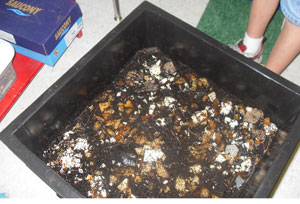• Composting yard waste recycles nutrients back into the yard and saves landfill space
• Composting reduces yard waste volume by 50 to 75 percent
• Compost made with manure is questionable for use in food gardens due to newer strains of bacteria that cause food-borne illnesses
• Placing red worms into compost can speed up the process
• Compost made from recycled waste works great as soil for gardens as well as mulch
• Adding compost to existing soil increases its water-holding capacity
• Compost can enhance plants’ ability to respond to challenges from insects and diseases
• DO NOT USE- meat, dairy, fats, oils, pet waste or weeds for composting
For more fun facts about composting visit Colorado University's website
How to Lasagna Compost
What is Lasagna Composting: some say this style of composting is the easiest to do and maintain. Because of its layering style of bedding and compost materials it is similar to the layering in the food dish lasagna, hence the name “Lasagna Composting”
Gardenguides.com gives a great 5 step process that outlines how to make a lasagna compost. Below are there exact 5 steps
Step 1 Select an area to lay out your lasagna compost, ideally a large, flat, well-draining location; it can be as large as you want, but try not to make it any smaller than 3- by 3-feet unless you enclose it in a frame. Cut any grass that will be under the compost location with your lawn mower, using the shortest setting to get rid of as much plant growth as possible. Mark the corners of your lasagna compost area with wooden stakes hammered into the ground; run a taut string between the stakes to mark the perimeter of your compost area.
Step 2 Cover the entire ground within the marked area with four to five layers of old newspaper. Overlap the edges of the newspaper to discourage weed and grass growth. Spray the newspaper gently with your garden hose until it is thoroughly wet.
Step 3 Spread a 2- to 3-inch layer of carbon-rich organic waste across the entire surface of the wet newspaper. Use dry materials to provide the carbon in your lasagna compost, including easy-to-find materials such as dead leaves, straw, old hay, shredded newspaper and cardboard. Dampen the waste with your garden hose; ideally, it should be about as moist as a wrung-out sponge.
Step 4 Top the dry, carbon waste with an equal layer of finely chopped nitrogen-rich material. Ideal nitrogen-rich materials are moist and green, including materials such as cow or horse manure, grass clippings, vegetable waste and fruit scraps. Alternate the two layers of waste repeatedly, until your lasagna compost is between 18 and 36 inches in height. End with a carbon layer to discourage fly populations, which like to lay their eggs in rich nitrogen scraps.
Step 5 Leave the lasagna compost bed alone to compost, allowing six months or more for the organic waste to break down to the point of being unrecognizable. Over time, the bed should decrease in height by about half and the organic waste should become crumbly and brown. Spread a 2- to 3-inch layer of plain topsoil over the mature lasagna compost to plant seeds or new seedlings directly into the nutrient-rich finished compost.

A Wire Composting Bin

Taking compost to the schools! The compost bin above is from a first grade classroom.

Another composting bin


